An Analysis of the Global Economy and Its Impact on Society
VerifiedAdded on 2022/12/15
|6
|2252
|220
Essay
AI Summary
This essay provides a comprehensive analysis of the global economy, focusing on the qualitative and quantitative transformations over the last few decades. It explores the impact of globalization on various aspects of society, including trade, investment, and the quality of life. The essay examines economic crises, such as the 2008 financial crisis, and their effects on different countries and communities, highlighting the increasing disparities between developed and developing nations. It also discusses the economic growth of countries like China and India, while also addressing issues like poverty, inequality, and the challenges of urbanization. The essay concludes with a call for addressing social tensions and improving the quality of life in developing countries, emphasizing the need for a more equitable global economic system. The essay uses references from various sources to support its arguments.
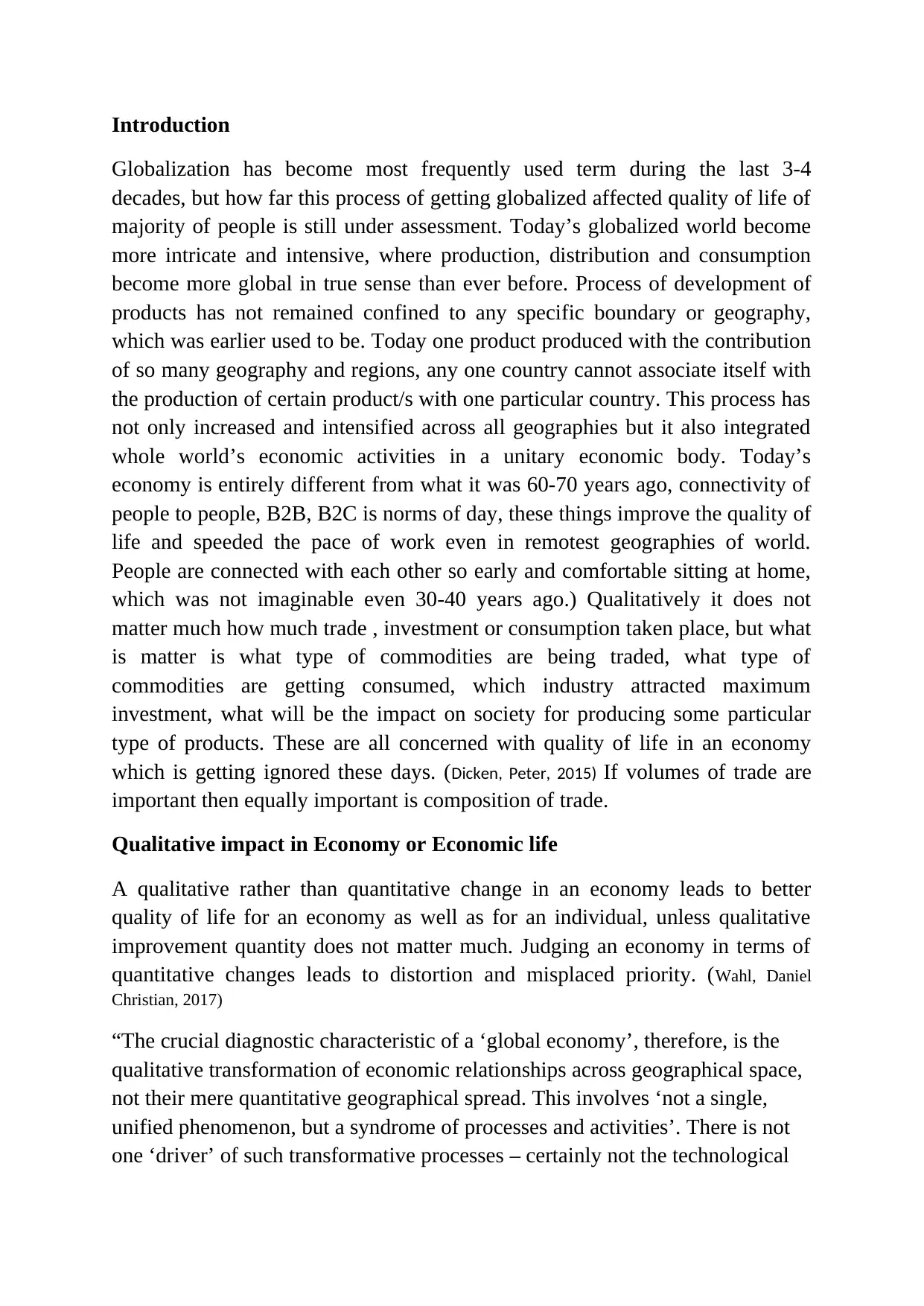
Introduction
Globalization has become most frequently used term during the last 3-4
decades, but how far this process of getting globalized affected quality of life of
majority of people is still under assessment. Today’s globalized world become
more intricate and intensive, where production, distribution and consumption
become more global in true sense than ever before. Process of development of
products has not remained confined to any specific boundary or geography,
which was earlier used to be. Today one product produced with the contribution
of so many geography and regions, any one country cannot associate itself with
the production of certain product/s with one particular country. This process has
not only increased and intensified across all geographies but it also integrated
whole world’s economic activities in a unitary economic body. Today’s
economy is entirely different from what it was 60-70 years ago, connectivity of
people to people, B2B, B2C is norms of day, these things improve the quality of
life and speeded the pace of work even in remotest geographies of world.
People are connected with each other so early and comfortable sitting at home,
which was not imaginable even 30-40 years ago.) Qualitatively it does not
matter much how much trade , investment or consumption taken place, but what
is matter is what type of commodities are being traded, what type of
commodities are getting consumed, which industry attracted maximum
investment, what will be the impact on society for producing some particular
type of products. These are all concerned with quality of life in an economy
which is getting ignored these days. (Dicken, Peter, 2015) If volumes of trade are
important then equally important is composition of trade.
Qualitative impact in Economy or Economic life
A qualitative rather than quantitative change in an economy leads to better
quality of life for an economy as well as for an individual, unless qualitative
improvement quantity does not matter much. Judging an economy in terms of
quantitative changes leads to distortion and misplaced priority. (Wahl, Daniel
Christian, 2017)
“The crucial diagnostic characteristic of a ‘global economy’, therefore, is the
qualitative transformation of economic relationships across geographical space,
not their mere quantitative geographical spread. This involves ‘not a single,
unified phenomenon, but a syndrome of processes and activities’. There is not
one ‘driver’ of such transformative processes – certainly not the technological
Globalization has become most frequently used term during the last 3-4
decades, but how far this process of getting globalized affected quality of life of
majority of people is still under assessment. Today’s globalized world become
more intricate and intensive, where production, distribution and consumption
become more global in true sense than ever before. Process of development of
products has not remained confined to any specific boundary or geography,
which was earlier used to be. Today one product produced with the contribution
of so many geography and regions, any one country cannot associate itself with
the production of certain product/s with one particular country. This process has
not only increased and intensified across all geographies but it also integrated
whole world’s economic activities in a unitary economic body. Today’s
economy is entirely different from what it was 60-70 years ago, connectivity of
people to people, B2B, B2C is norms of day, these things improve the quality of
life and speeded the pace of work even in remotest geographies of world.
People are connected with each other so early and comfortable sitting at home,
which was not imaginable even 30-40 years ago.) Qualitatively it does not
matter much how much trade , investment or consumption taken place, but what
is matter is what type of commodities are being traded, what type of
commodities are getting consumed, which industry attracted maximum
investment, what will be the impact on society for producing some particular
type of products. These are all concerned with quality of life in an economy
which is getting ignored these days. (Dicken, Peter, 2015) If volumes of trade are
important then equally important is composition of trade.
Qualitative impact in Economy or Economic life
A qualitative rather than quantitative change in an economy leads to better
quality of life for an economy as well as for an individual, unless qualitative
improvement quantity does not matter much. Judging an economy in terms of
quantitative changes leads to distortion and misplaced priority. (Wahl, Daniel
Christian, 2017)
“The crucial diagnostic characteristic of a ‘global economy’, therefore, is the
qualitative transformation of economic relationships across geographical space,
not their mere quantitative geographical spread. This involves ‘not a single,
unified phenomenon, but a syndrome of processes and activities’. There is not
one ‘driver’ of such transformative processes – certainly not the technological
Paraphrase This Document
Need a fresh take? Get an instant paraphrase of this document with our AI Paraphraser
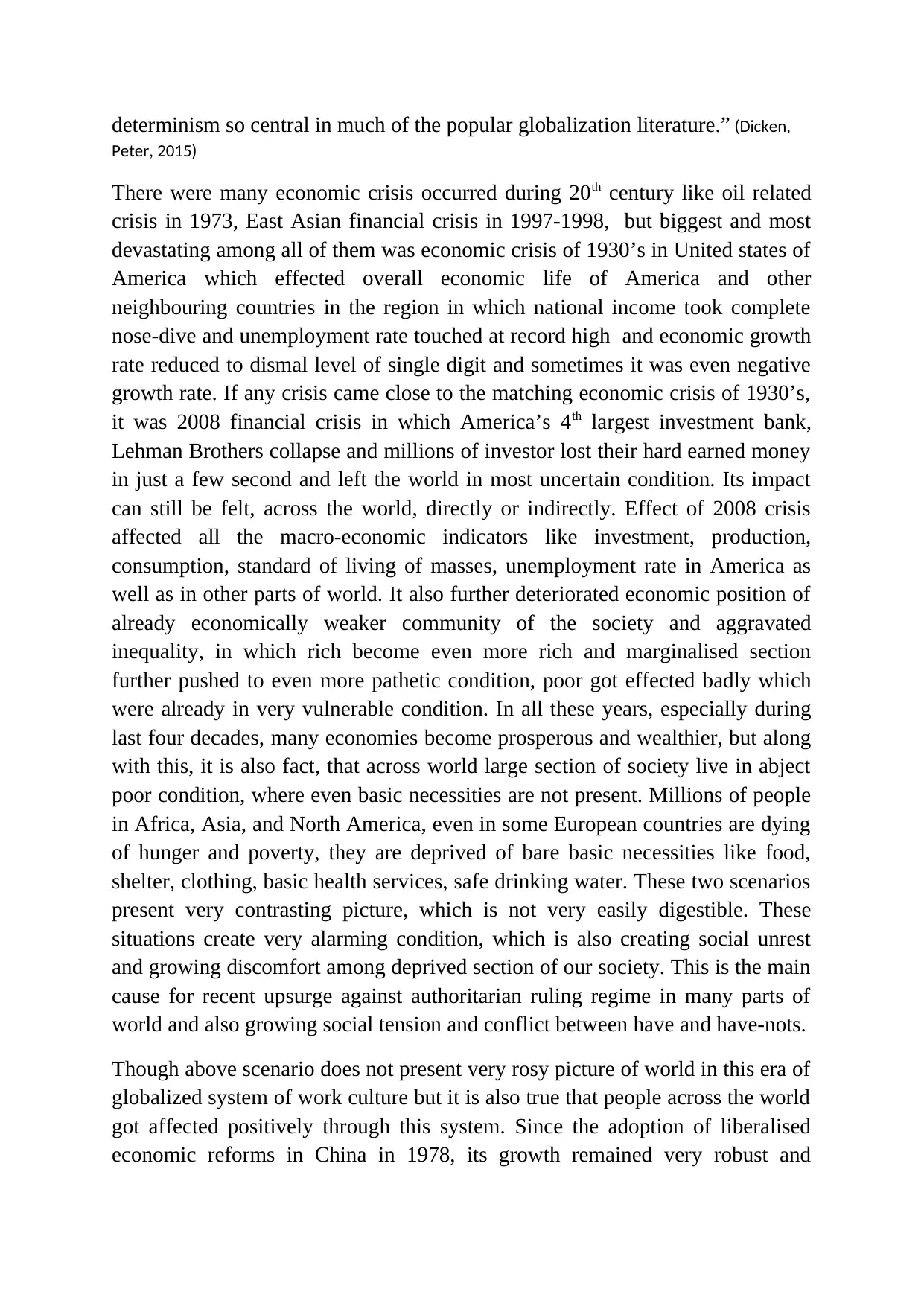
determinism so central in much of the popular globalization literature.” (Dicken,
Peter, 2015)
There were many economic crisis occurred during 20th century like oil related
crisis in 1973, East Asian financial crisis in 1997-1998, but biggest and most
devastating among all of them was economic crisis of 1930’s in United states of
America which effected overall economic life of America and other
neighbouring countries in the region in which national income took complete
nose-dive and unemployment rate touched at record high and economic growth
rate reduced to dismal level of single digit and sometimes it was even negative
growth rate. If any crisis came close to the matching economic crisis of 1930’s,
it was 2008 financial crisis in which America’s 4th largest investment bank,
Lehman Brothers collapse and millions of investor lost their hard earned money
in just a few second and left the world in most uncertain condition. Its impact
can still be felt, across the world, directly or indirectly. Effect of 2008 crisis
affected all the macro-economic indicators like investment, production,
consumption, standard of living of masses, unemployment rate in America as
well as in other parts of world. It also further deteriorated economic position of
already economically weaker community of the society and aggravated
inequality, in which rich become even more rich and marginalised section
further pushed to even more pathetic condition, poor got effected badly which
were already in very vulnerable condition. In all these years, especially during
last four decades, many economies become prosperous and wealthier, but along
with this, it is also fact, that across world large section of society live in abject
poor condition, where even basic necessities are not present. Millions of people
in Africa, Asia, and North America, even in some European countries are dying
of hunger and poverty, they are deprived of bare basic necessities like food,
shelter, clothing, basic health services, safe drinking water. These two scenarios
present very contrasting picture, which is not very easily digestible. These
situations create very alarming condition, which is also creating social unrest
and growing discomfort among deprived section of our society. This is the main
cause for recent upsurge against authoritarian ruling regime in many parts of
world and also growing social tension and conflict between have and have-nots.
Though above scenario does not present very rosy picture of world in this era of
globalized system of work culture but it is also true that people across the world
got affected positively through this system. Since the adoption of liberalised
economic reforms in China in 1978, its growth remained very robust and
Peter, 2015)
There were many economic crisis occurred during 20th century like oil related
crisis in 1973, East Asian financial crisis in 1997-1998, but biggest and most
devastating among all of them was economic crisis of 1930’s in United states of
America which effected overall economic life of America and other
neighbouring countries in the region in which national income took complete
nose-dive and unemployment rate touched at record high and economic growth
rate reduced to dismal level of single digit and sometimes it was even negative
growth rate. If any crisis came close to the matching economic crisis of 1930’s,
it was 2008 financial crisis in which America’s 4th largest investment bank,
Lehman Brothers collapse and millions of investor lost their hard earned money
in just a few second and left the world in most uncertain condition. Its impact
can still be felt, across the world, directly or indirectly. Effect of 2008 crisis
affected all the macro-economic indicators like investment, production,
consumption, standard of living of masses, unemployment rate in America as
well as in other parts of world. It also further deteriorated economic position of
already economically weaker community of the society and aggravated
inequality, in which rich become even more rich and marginalised section
further pushed to even more pathetic condition, poor got effected badly which
were already in very vulnerable condition. In all these years, especially during
last four decades, many economies become prosperous and wealthier, but along
with this, it is also fact, that across world large section of society live in abject
poor condition, where even basic necessities are not present. Millions of people
in Africa, Asia, and North America, even in some European countries are dying
of hunger and poverty, they are deprived of bare basic necessities like food,
shelter, clothing, basic health services, safe drinking water. These two scenarios
present very contrasting picture, which is not very easily digestible. These
situations create very alarming condition, which is also creating social unrest
and growing discomfort among deprived section of our society. This is the main
cause for recent upsurge against authoritarian ruling regime in many parts of
world and also growing social tension and conflict between have and have-nots.
Though above scenario does not present very rosy picture of world in this era of
globalized system of work culture but it is also true that people across the world
got affected positively through this system. Since the adoption of liberalised
economic reforms in China in 1978, its growth remained very robust and
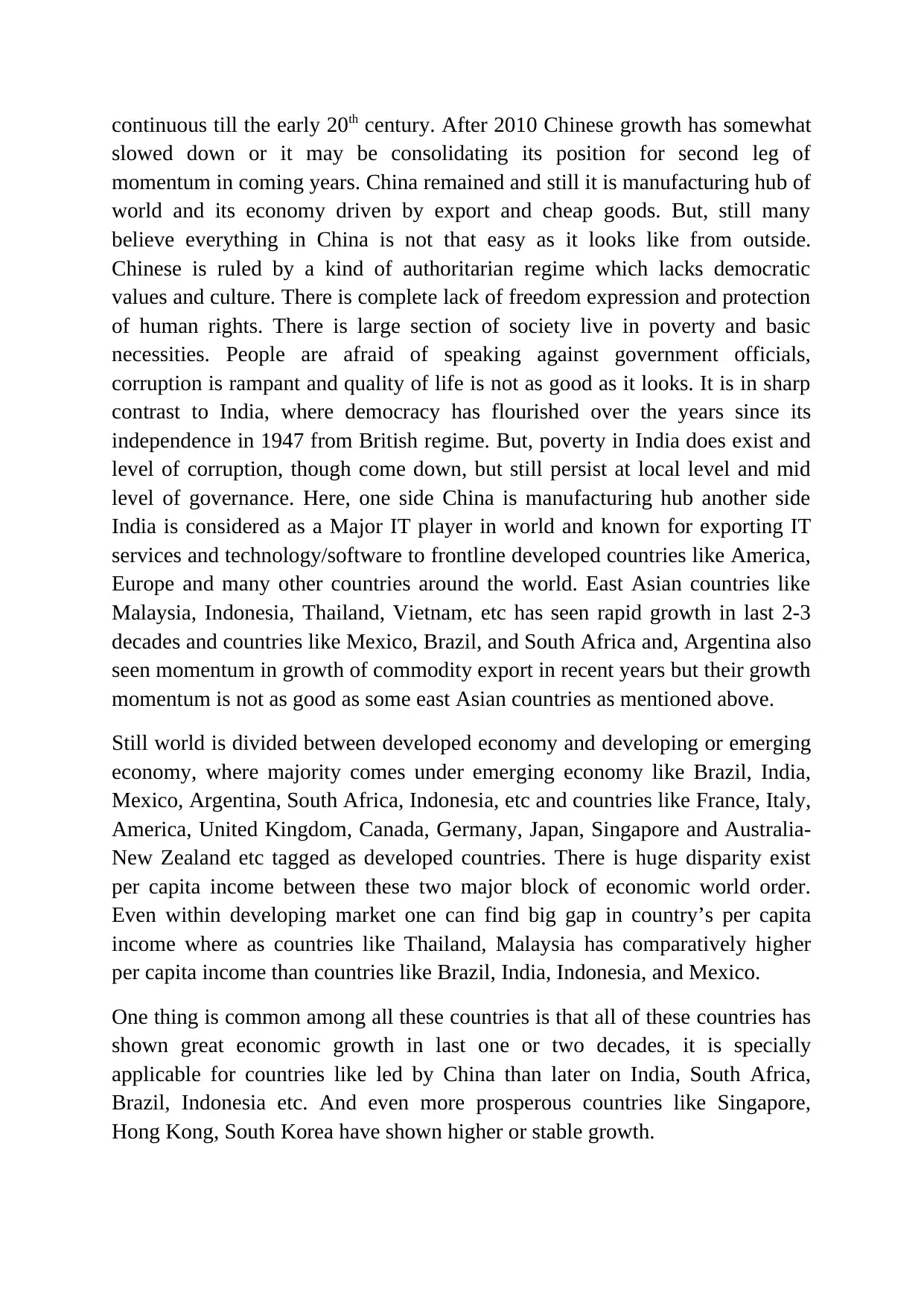
continuous till the early 20th century. After 2010 Chinese growth has somewhat
slowed down or it may be consolidating its position for second leg of
momentum in coming years. China remained and still it is manufacturing hub of
world and its economy driven by export and cheap goods. But, still many
believe everything in China is not that easy as it looks like from outside.
Chinese is ruled by a kind of authoritarian regime which lacks democratic
values and culture. There is complete lack of freedom expression and protection
of human rights. There is large section of society live in poverty and basic
necessities. People are afraid of speaking against government officials,
corruption is rampant and quality of life is not as good as it looks. It is in sharp
contrast to India, where democracy has flourished over the years since its
independence in 1947 from British regime. But, poverty in India does exist and
level of corruption, though come down, but still persist at local level and mid
level of governance. Here, one side China is manufacturing hub another side
India is considered as a Major IT player in world and known for exporting IT
services and technology/software to frontline developed countries like America,
Europe and many other countries around the world. East Asian countries like
Malaysia, Indonesia, Thailand, Vietnam, etc has seen rapid growth in last 2-3
decades and countries like Mexico, Brazil, and South Africa and, Argentina also
seen momentum in growth of commodity export in recent years but their growth
momentum is not as good as some east Asian countries as mentioned above.
Still world is divided between developed economy and developing or emerging
economy, where majority comes under emerging economy like Brazil, India,
Mexico, Argentina, South Africa, Indonesia, etc and countries like France, Italy,
America, United Kingdom, Canada, Germany, Japan, Singapore and Australia-
New Zealand etc tagged as developed countries. There is huge disparity exist
per capita income between these two major block of economic world order.
Even within developing market one can find big gap in country’s per capita
income where as countries like Thailand, Malaysia has comparatively higher
per capita income than countries like Brazil, India, Indonesia, and Mexico.
One thing is common among all these countries is that all of these countries has
shown great economic growth in last one or two decades, it is specially
applicable for countries like led by China than later on India, South Africa,
Brazil, Indonesia etc. And even more prosperous countries like Singapore,
Hong Kong, South Korea have shown higher or stable growth.
slowed down or it may be consolidating its position for second leg of
momentum in coming years. China remained and still it is manufacturing hub of
world and its economy driven by export and cheap goods. But, still many
believe everything in China is not that easy as it looks like from outside.
Chinese is ruled by a kind of authoritarian regime which lacks democratic
values and culture. There is complete lack of freedom expression and protection
of human rights. There is large section of society live in poverty and basic
necessities. People are afraid of speaking against government officials,
corruption is rampant and quality of life is not as good as it looks. It is in sharp
contrast to India, where democracy has flourished over the years since its
independence in 1947 from British regime. But, poverty in India does exist and
level of corruption, though come down, but still persist at local level and mid
level of governance. Here, one side China is manufacturing hub another side
India is considered as a Major IT player in world and known for exporting IT
services and technology/software to frontline developed countries like America,
Europe and many other countries around the world. East Asian countries like
Malaysia, Indonesia, Thailand, Vietnam, etc has seen rapid growth in last 2-3
decades and countries like Mexico, Brazil, and South Africa and, Argentina also
seen momentum in growth of commodity export in recent years but their growth
momentum is not as good as some east Asian countries as mentioned above.
Still world is divided between developed economy and developing or emerging
economy, where majority comes under emerging economy like Brazil, India,
Mexico, Argentina, South Africa, Indonesia, etc and countries like France, Italy,
America, United Kingdom, Canada, Germany, Japan, Singapore and Australia-
New Zealand etc tagged as developed countries. There is huge disparity exist
per capita income between these two major block of economic world order.
Even within developing market one can find big gap in country’s per capita
income where as countries like Thailand, Malaysia has comparatively higher
per capita income than countries like Brazil, India, Indonesia, and Mexico.
One thing is common among all these countries is that all of these countries has
shown great economic growth in last one or two decades, it is specially
applicable for countries like led by China than later on India, South Africa,
Brazil, Indonesia etc. And even more prosperous countries like Singapore,
Hong Kong, South Korea have shown higher or stable growth.
⊘ This is a preview!⊘
Do you want full access?
Subscribe today to unlock all pages.

Trusted by 1+ million students worldwide
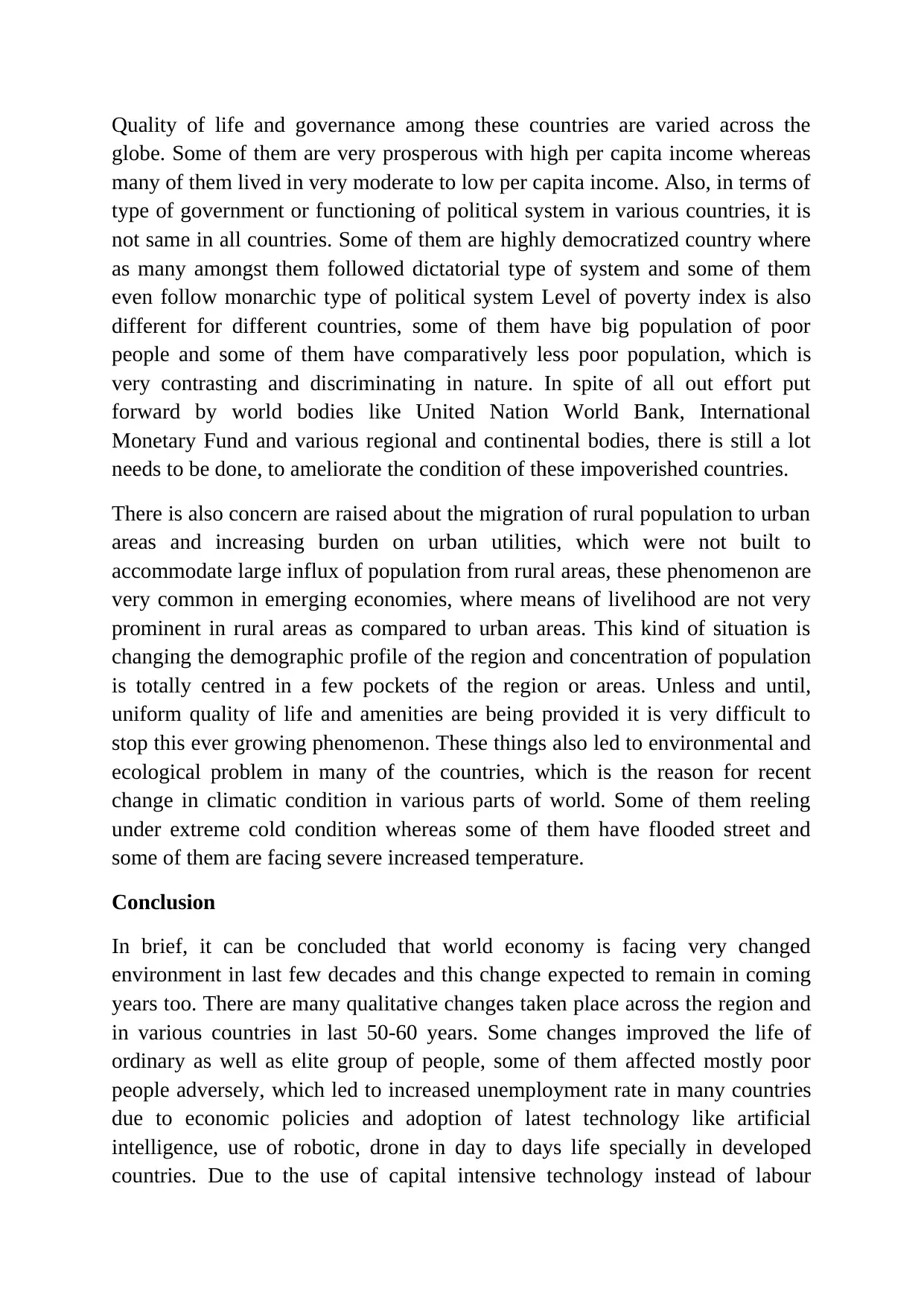
Quality of life and governance among these countries are varied across the
globe. Some of them are very prosperous with high per capita income whereas
many of them lived in very moderate to low per capita income. Also, in terms of
type of government or functioning of political system in various countries, it is
not same in all countries. Some of them are highly democratized country where
as many amongst them followed dictatorial type of system and some of them
even follow monarchic type of political system Level of poverty index is also
different for different countries, some of them have big population of poor
people and some of them have comparatively less poor population, which is
very contrasting and discriminating in nature. In spite of all out effort put
forward by world bodies like United Nation World Bank, International
Monetary Fund and various regional and continental bodies, there is still a lot
needs to be done, to ameliorate the condition of these impoverished countries.
There is also concern are raised about the migration of rural population to urban
areas and increasing burden on urban utilities, which were not built to
accommodate large influx of population from rural areas, these phenomenon are
very common in emerging economies, where means of livelihood are not very
prominent in rural areas as compared to urban areas. This kind of situation is
changing the demographic profile of the region and concentration of population
is totally centred in a few pockets of the region or areas. Unless and until,
uniform quality of life and amenities are being provided it is very difficult to
stop this ever growing phenomenon. These things also led to environmental and
ecological problem in many of the countries, which is the reason for recent
change in climatic condition in various parts of world. Some of them reeling
under extreme cold condition whereas some of them have flooded street and
some of them are facing severe increased temperature.
Conclusion
In brief, it can be concluded that world economy is facing very changed
environment in last few decades and this change expected to remain in coming
years too. There are many qualitative changes taken place across the region and
in various countries in last 50-60 years. Some changes improved the life of
ordinary as well as elite group of people, some of them affected mostly poor
people adversely, which led to increased unemployment rate in many countries
due to economic policies and adoption of latest technology like artificial
intelligence, use of robotic, drone in day to days life specially in developed
countries. Due to the use of capital intensive technology instead of labour
globe. Some of them are very prosperous with high per capita income whereas
many of them lived in very moderate to low per capita income. Also, in terms of
type of government or functioning of political system in various countries, it is
not same in all countries. Some of them are highly democratized country where
as many amongst them followed dictatorial type of system and some of them
even follow monarchic type of political system Level of poverty index is also
different for different countries, some of them have big population of poor
people and some of them have comparatively less poor population, which is
very contrasting and discriminating in nature. In spite of all out effort put
forward by world bodies like United Nation World Bank, International
Monetary Fund and various regional and continental bodies, there is still a lot
needs to be done, to ameliorate the condition of these impoverished countries.
There is also concern are raised about the migration of rural population to urban
areas and increasing burden on urban utilities, which were not built to
accommodate large influx of population from rural areas, these phenomenon are
very common in emerging economies, where means of livelihood are not very
prominent in rural areas as compared to urban areas. This kind of situation is
changing the demographic profile of the region and concentration of population
is totally centred in a few pockets of the region or areas. Unless and until,
uniform quality of life and amenities are being provided it is very difficult to
stop this ever growing phenomenon. These things also led to environmental and
ecological problem in many of the countries, which is the reason for recent
change in climatic condition in various parts of world. Some of them reeling
under extreme cold condition whereas some of them have flooded street and
some of them are facing severe increased temperature.
Conclusion
In brief, it can be concluded that world economy is facing very changed
environment in last few decades and this change expected to remain in coming
years too. There are many qualitative changes taken place across the region and
in various countries in last 50-60 years. Some changes improved the life of
ordinary as well as elite group of people, some of them affected mostly poor
people adversely, which led to increased unemployment rate in many countries
due to economic policies and adoption of latest technology like artificial
intelligence, use of robotic, drone in day to days life specially in developed
countries. Due to the use of capital intensive technology instead of labour
Paraphrase This Document
Need a fresh take? Get an instant paraphrase of this document with our AI Paraphraser
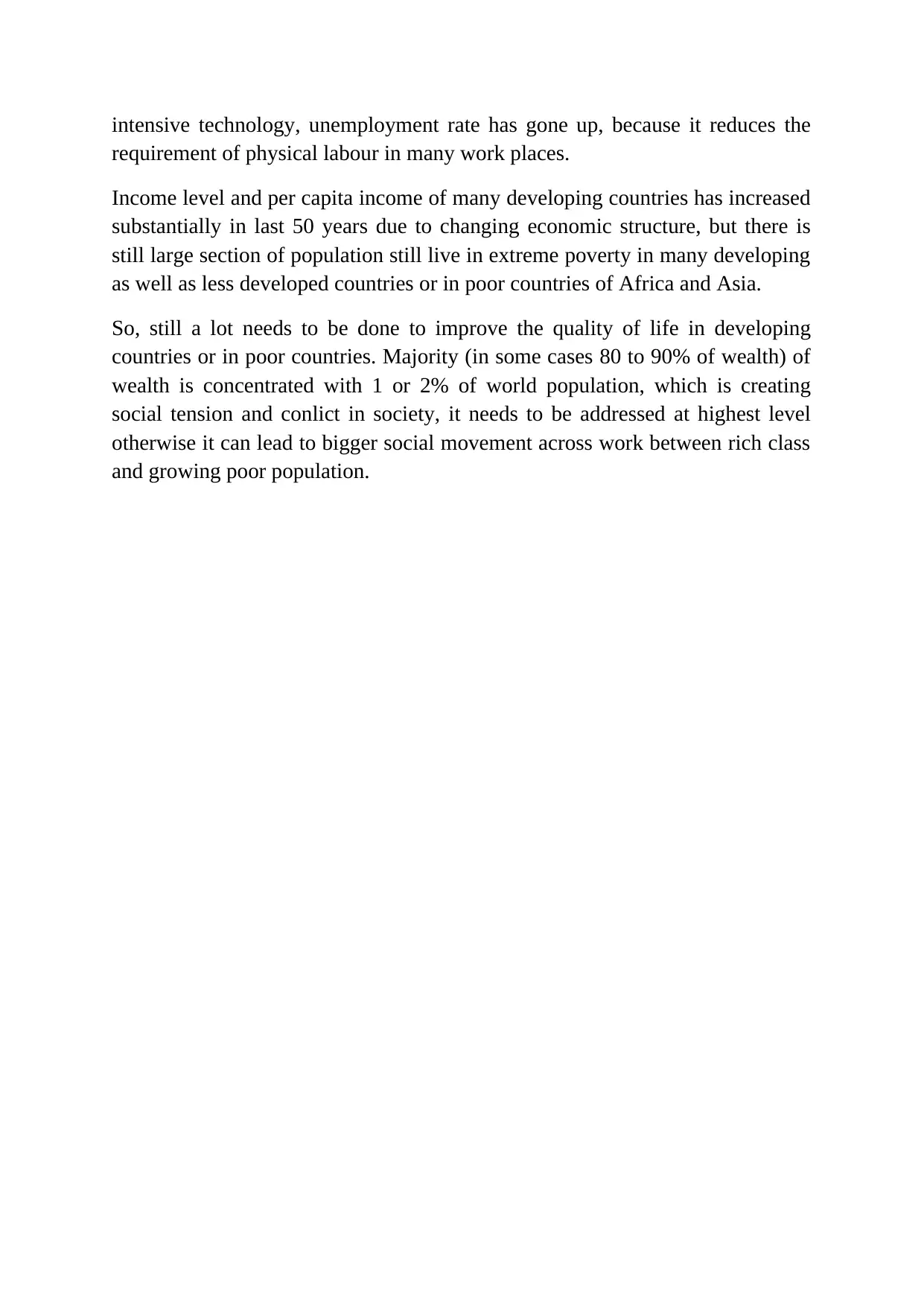
intensive technology, unemployment rate has gone up, because it reduces the
requirement of physical labour in many work places.
Income level and per capita income of many developing countries has increased
substantially in last 50 years due to changing economic structure, but there is
still large section of population still live in extreme poverty in many developing
as well as less developed countries or in poor countries of Africa and Asia.
So, still a lot needs to be done to improve the quality of life in developing
countries or in poor countries. Majority (in some cases 80 to 90% of wealth) of
wealth is concentrated with 1 or 2% of world population, which is creating
social tension and conlict in society, it needs to be addressed at highest level
otherwise it can lead to bigger social movement across work between rich class
and growing poor population.
requirement of physical labour in many work places.
Income level and per capita income of many developing countries has increased
substantially in last 50 years due to changing economic structure, but there is
still large section of population still live in extreme poverty in many developing
as well as less developed countries or in poor countries of Africa and Asia.
So, still a lot needs to be done to improve the quality of life in developing
countries or in poor countries. Majority (in some cases 80 to 90% of wealth) of
wealth is concentrated with 1 or 2% of world population, which is creating
social tension and conlict in society, it needs to be addressed at highest level
otherwise it can lead to bigger social movement across work between rich class
and growing poor population.
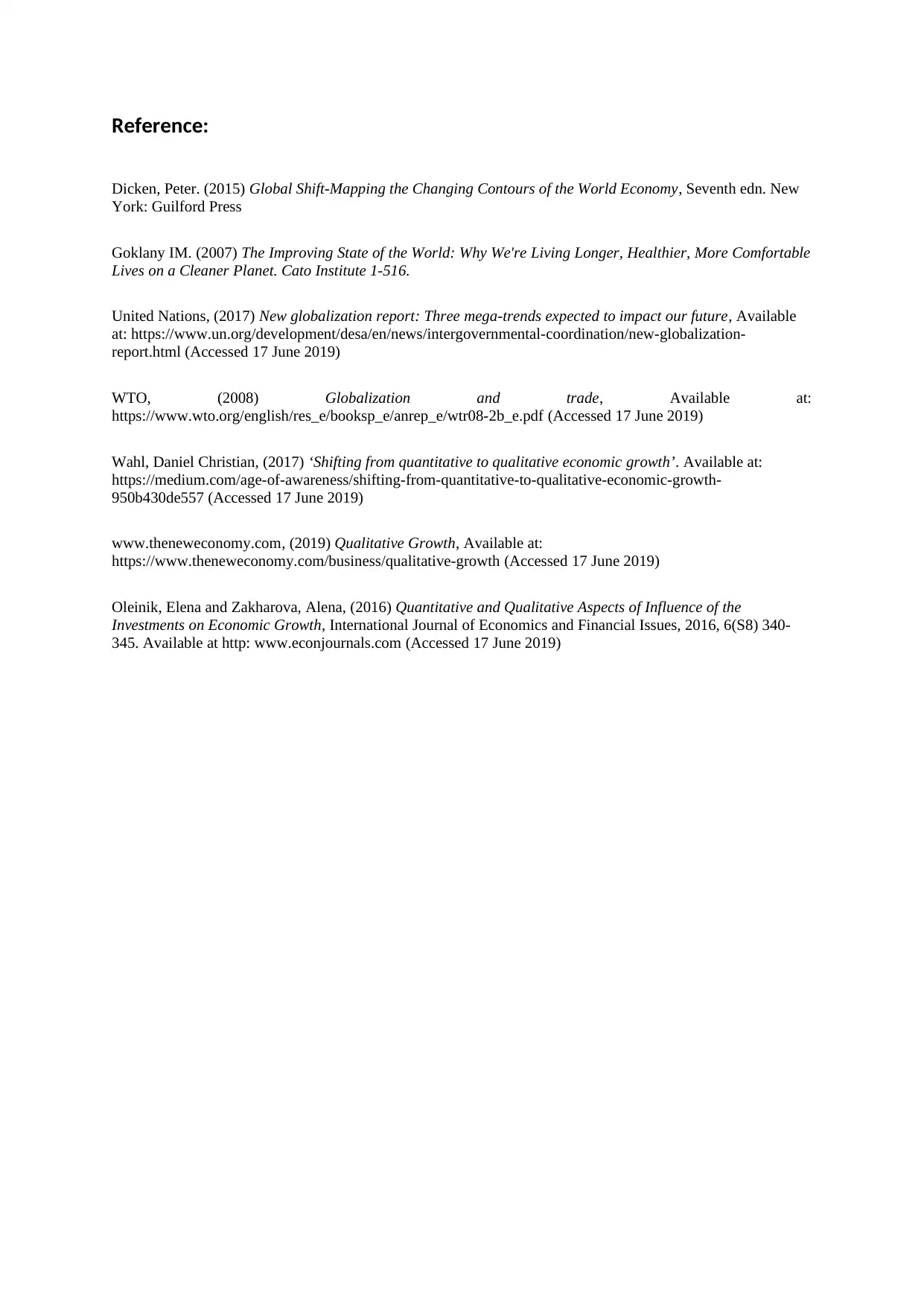
Reference:
Dicken, Peter. (2015) Global Shift-Mapping the Changing Contours of the World Economy, Seventh edn. New
York: Guilford Press
Goklany IM. (2007) The Improving State of the World: Why We're Living Longer, Healthier, More Comfortable
Lives on a Cleaner Planet. Cato Institute 1-516.
United Nations, (2017) New globalization report: Three mega-trends expected to impact our future, Available
at: https://www.un.org/development/desa/en/news/intergovernmental-coordination/new-globalization-
report.html (Accessed 17 June 2019)
WTO, (2008) Globalization and trade, Available at:
https://www.wto.org/english/res_e/booksp_e/anrep_e/wtr08-2b_e.pdf (Accessed 17 June 2019)
Wahl, Daniel Christian, (2017) ‘Shifting from quantitative to qualitative economic growth’. Available at:
https://medium.com/age-of-awareness/shifting-from-quantitative-to-qualitative-economic-growth-
950b430de557 (Accessed 17 June 2019)
www.theneweconomy.com, (2019) Qualitative Growth, Available at:
https://www.theneweconomy.com/business/qualitative-growth (Accessed 17 June 2019)
Oleinik, Elena and Zakharova, Alena, (2016) Quantitative and Qualitative Aspects of Influence of the
Investments on Economic Growth, International Journal of Economics and Financial Issues, 2016, 6(S8) 340-
345. Available at http: www.econjournals.com (Accessed 17 June 2019)
Dicken, Peter. (2015) Global Shift-Mapping the Changing Contours of the World Economy, Seventh edn. New
York: Guilford Press
Goklany IM. (2007) The Improving State of the World: Why We're Living Longer, Healthier, More Comfortable
Lives on a Cleaner Planet. Cato Institute 1-516.
United Nations, (2017) New globalization report: Three mega-trends expected to impact our future, Available
at: https://www.un.org/development/desa/en/news/intergovernmental-coordination/new-globalization-
report.html (Accessed 17 June 2019)
WTO, (2008) Globalization and trade, Available at:
https://www.wto.org/english/res_e/booksp_e/anrep_e/wtr08-2b_e.pdf (Accessed 17 June 2019)
Wahl, Daniel Christian, (2017) ‘Shifting from quantitative to qualitative economic growth’. Available at:
https://medium.com/age-of-awareness/shifting-from-quantitative-to-qualitative-economic-growth-
950b430de557 (Accessed 17 June 2019)
www.theneweconomy.com, (2019) Qualitative Growth, Available at:
https://www.theneweconomy.com/business/qualitative-growth (Accessed 17 June 2019)
Oleinik, Elena and Zakharova, Alena, (2016) Quantitative and Qualitative Aspects of Influence of the
Investments on Economic Growth, International Journal of Economics and Financial Issues, 2016, 6(S8) 340-
345. Available at http: www.econjournals.com (Accessed 17 June 2019)
⊘ This is a preview!⊘
Do you want full access?
Subscribe today to unlock all pages.

Trusted by 1+ million students worldwide
1 out of 6
Your All-in-One AI-Powered Toolkit for Academic Success.
+13062052269
info@desklib.com
Available 24*7 on WhatsApp / Email
![[object Object]](/_next/static/media/star-bottom.7253800d.svg)
Unlock your academic potential
Copyright © 2020–2025 A2Z Services. All Rights Reserved. Developed and managed by ZUCOL.


